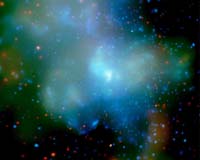
Astronomers Find Part Of Universe’s Missing Matter — So if this is all true how is interstellar trave ever possible? I mean, these gas clouds surround us and are hotter than the sun. Ouch.
This new study shows that the missing baryons are still out there, Mathur said, they’re just floating in gas that is too hot to see with an optical telescope.
The gas that surrounds our galaxy, for example, is 100 times hotter than the sun — so hot that it shines in high-energy X-rays instead of lower-energy visible light.
via E. Campbell















temperature in space is not the same as temperature in an atmosphere…
It’s hot and THIN plasma. I suspect the actual density to be infinitesimal.
Temperature is temperature, whether in the atmosphere or in space. It measures the average kinetic energy of the gas particles. If there aren’t a lot of particles, then their average energy can be very high while the total energy content of the gas is very low. The total energy determines how quickly (or whether) you will be baked since that is how much energy is available to be delivered to your skin. In science jargon, heat capacity and specific heat are very different. If very high energy (and therefore very high temperature) particles collide with you, but they only do it once a week on average, then the total energy transferred to you is insignificant and you won’t notice.